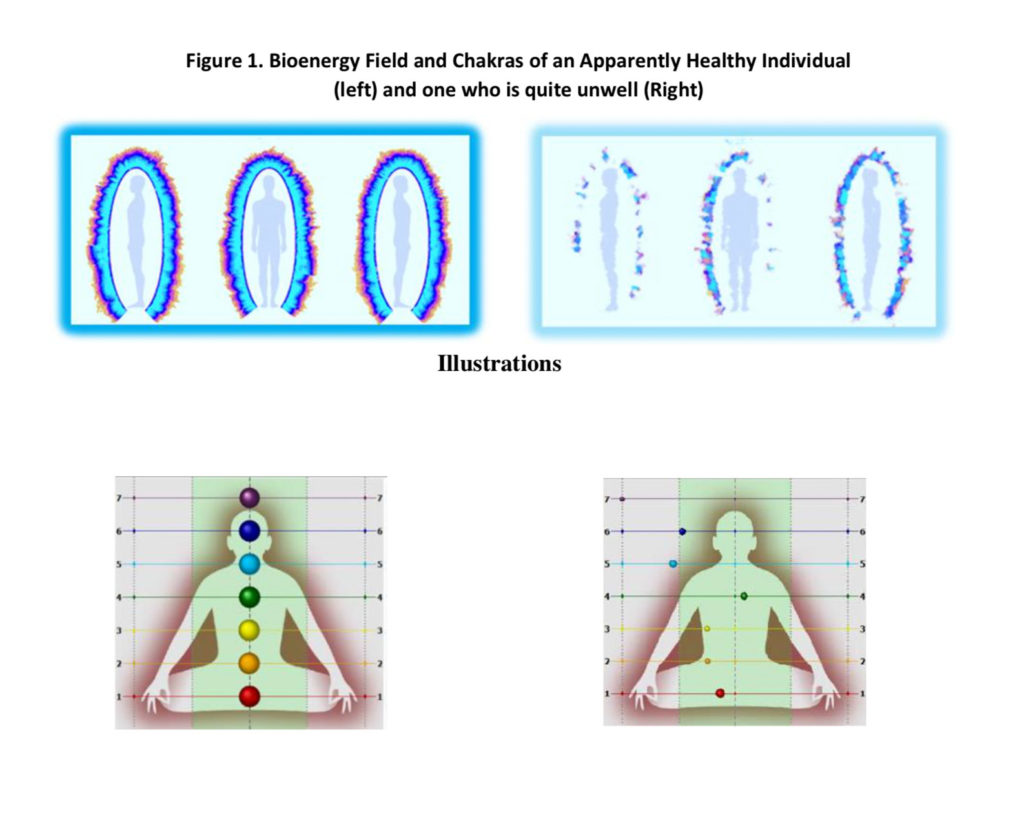Noninvasive Indicators of Stress and Bioenergy Disruption & Benefit of Meditation in Relieving Stress
Pradeep B. Deshpande*1 & Konstantin Korotkov3
1Department of Chemical Engineering, University of Louisville; & Six Sigma & Advanced Controls, Inc.
P.O. Box 22664, Louisville, KY
3Department of Biophysics and Computers, St. Petersburg Federal University of Informational Technologies, Optics, and Mechanics, St. Petersburg, Russia
Abstract
The bioenergy field of seven individuals known to be suffering from chronically high stress levels was measured with a gas-discharge-visualization (GDV) device revealing that their bioenergy fields were severely disrupted recording high to very high numerical values of stress levels and severely off-balance chakras. Stress is known to be a marker for a number of ailments and has been shown to have a negative effect on aging. Since meditation has been shown to reverse the negative effect of stress, the information reported in this paper nicely supplements and complements traditional medical approaches to illnesses and should be useful in the light of the ever-increasing healthcare costs.
Keywords: stress, bioenergy, telomeres, aging, sickness, meditation.
Introduction
High level of stress has been shown to shorten telomere length and lower telomerase level with an adverse effect on aging as well as a variety of ailments but the telomere measurement requires the analysis of blood samples. Disruptions in our bioenergy levels are suggested to occur well before the negative effect of stress is revealed in the form of telomeres shortening and lowering of telomerase levels and subsequent manifestation of ailments in the body.
High level of stress is also known to be a root cause of number of ailments and has been implicated in accelerated aging (Epel, et al., 2004). Developing restorative methods to slow down or even reverse the negative effects of stress on health consists of two tasks: (1) To find measurement methods indicative of elevated stress levels, in addition to routine measurements such as blood pressure, and (2) Develop methods to reverse the negative effects of stress and demonstrate their efficacy with the measurement methodology in (1).
Elizabeth Blackburn and associates discovered in the seventies that the tips of human chromosomes called telomeres act as caps to protect the ends of our chromosomes each time our cells are divided and the DNA is copied. They also discovered that an enzyme called telomerase can protect and rebuild telomeres. As we age, telomeres dwindle and when they get too short, our cells malfunction and lose their ability to divide and this is a key process that contributes to aging. This work eventually earned Dr. Blackburn the 2009 Nobel Prize in physiology and medicine.
Elissa Epel subsequently collaborated with Blackburn showing that telomerase levels and telomeres length are strongly correlated with stress levels and that they affect aging. For their project the team meticulously recruited fifty-eight women who were caring for their chronically ill children. The results showed that the more stressed the women said they were, the shorter were their telomeres and lower the telomerase levels (Epel, et al., 2004). This finding is significant since high stress levels are known to contribute to a large number of ailments including cancer. The investigators also found that while exercises, eating healthy, social support, etc., were all restorative, meditation was the most effective intervention capable of slowing the erosion of telomeres.
In this context, the work of Korotkov’s group assumes significance. In the nineties, the Korotkov team developed a device called Gas Discharge Visualization (GDV) device for measuring the bioenergy field of humans (see also Pehlek, 1976). This device offers a painless, noninvasive, cost-effective, and virtually instantaneous measurement of bioenergy, stress levels, and the state of Chakras.
In this paper, we present the results of GDV measurements of seven volunteers in Russia with a specific focus on stress levels and show how this technology may offer prospects for large-scale applications and is a good tool in self-help programs. Evidence of the restorative benefits of meditation on the bioenergy field, stress levels, and the state of the chakras is also presented.
Results of This Study
To begin, refer to Figure 1 which shows the bioenergy and chakras of an apparently healthy individual and another who is quite unwell. Notice the dramatic difference between a normal individual’s energy field and the disrupted energy field of the unwell individual. Furthermore, all seven chakras of the normal individual are centered and properly sized. Conversely, the chakras of the unwell individual are small and off-centered.
This report involves seven individuals thought to be chronically stressed. Figure 2 shows the bioenergy, numerical values of stress, and the state of chakras of these individuals. The stress levels of all seven subject are high to very high; normal range is 2 to 4; The figures show that the higher the stress level, the more disrupted the energy field, and more unbalanced the chakras. Admittedly the sample size is rather small but the trends are unmistakable.
Figure 3(a) depicts the Before and After GDV images of Rosa who was thought to be suffering from an elevated level of stress over a weekend meditation course in Spain’s a few years ago. Rosa reportedly began the weekend program in a very distressed state. She had significantly low energy and high stress levels, and felt nervous and anxious. After just two and a half days of meditation, her energy levels had improved dramatically and her stress levels had reduced. She reported feeling comfortable and relaxed and could not believe the improvement she felt from the weekend course. Figure 3(b) depicts the same information for Alfonso in another meditation program.
Full text PDF: Stress Meditation Deshpande Korotkov

